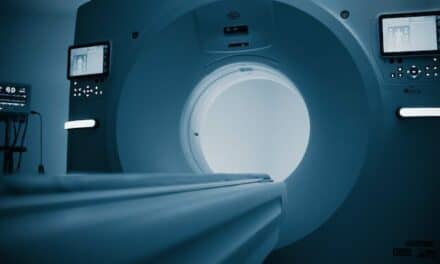New tools powered by artificial intelligence are helping healthcare professionals—including those in HTM—provide better care. Here’s how.
By Chris Hayhurst
Each year, tens of thousands of Americans are admitted to hospitals with a collapsed lung. Also known as a pneumothorax, and caused by anything from trauma to cystic fibrosis, the condition occurs when air makes its way into the space between the lung and chest wall. Pneumothoraces are usually painful, but more importantly, they can also be deadly. A serious pneumothorax with significant lung collapse requires treatment right away.
Those facts had to be top of mind for the GE Healthcare engineers who developed the company’s latest solution in medical imaging. This fall, GE announced that it had received the first-ever FDA clearance of an artificial intelligence-powered application that can be embedded on a mobile x-ray device to speed up image review. In the case of a collapsed lung, according to Katelyn Nye, GE’s general manager of global mobile radiography and artificial intelligence, the technology—dubbed “Critical Care Suite”—can cut the time required for detection from multiple hours to just a few minutes.
The app uses several AI algorithms that GE trained on thousands of images garnered from detectors from 11 different manufacturers, Nye explains. One of the algorithms, for example, automatically rotates an incorrectly oriented image into an upright position, while another looks at the image itself to ensure it includes the intended field of view. And then, Nye says, there’s the “critical findings” algorithm, which quickly and automatically analyzes images and flags those deemed likely to show a pneumothorax.
When a collapsed lung is suspected, an alert is sent, along with the original chest x-ray (via a picture archiving and communication system, or PACS), to the radiologist for review. “A pneumothorax can be difficult to detect—they may be very subtle,” she explains. “But it’s also something that you don’t want to miss, because if it’s not monitored or treated the lung can continue to collapse.” GE Healthcare’s intention with artificial intelligence is not to negate the need for skilled technologists and physicians who can professionally diagnose when a pneumothorax is present. It’s to “speed up the triaging of high-priority cases so they can make those diagnoses in the first place,” Nye says.
Transforming Healthcare Delivery
According to a recent report by Signify Research, the world market for artificial intelligence tools in medical imaging is expected to top $2 billion by 2023. Leading the way in the medical AI arena are the usual giants like GE—but also fighting for space in the industry are dozens of startups that are not yet household names.
A San Francisco-based company called Arterys, for example, now offers several imaging solutions that combine artificial intelligence with cloud computing to “augment” the radiology workflow; while HeartFlow, a firm founded in 2007, incorporates AI into standard CT scanning to build a “personalized digital model” of a patient’s coronary arteries.
The boom in AI-driven systems and applications seems perfectly timed to meet rising demand by healthcare providers for technologies that can help them work more efficiently and effectively. As Medicare and other payers offer incentives to health systems for reducing costs and improving outcomes, medical devices infused with AI capabilities promise to make that work a lot easier.
“Artificial intelligence and machine learning have the potential to fundamentally transform the delivery of healthcare,” noted former FDA commissioner Scott Gottlieb, MD, in a statement published earlier this year. “As technology and science advance, we can expect to see earlier disease detection, more accurate diagnosis, more targeted therapies, and significant improvements in personalized medicine.” In 2018, Gottlieb said, the FDA had approved two notable devices that deployed AI to facilitate image analysis, including one that could be used to detect diabetic retinopathy and another that helps clinicians identify potential strokes. “The authorization of these technologies was a harbinger of progress,” he said, and a sign that AI’s time had come.
An “Exciting Time” for Imaging
One company that agrees with that assessment is IBM Watson Health in Cambridge, Mass. The firm’s “Watson Health Imaging” segment, where Mandy Long is director of Offering Management, now offers two AI solutions: IBM Watson Imaging Clinical Review and IBM Watson Imaging Patient Synopsis. Clinical Review, according to IBM, is a “retrospective AI-enabled data review tool that helps support a reliable patient record” to facilitate care coordination, while Patient Synopsis is a “radiologist-trained AI tool” that extracts patient information from electronic health records to help radiologists make diagnostic decisions.
“It’s certainly an exciting time in the industry,” Long says, calling artificial intelligence and its impact on imaging “almost revolutionary.” In IBM Watson Health’s case, she explains, they’re investing in two types of AI solutions. The first is centered on natural language processing and turning unstructured data, like clinical notes, into something immediately usable for physicians. And the second revolves around image analysis and the automation of disease detection and characterization.
“It’s about how can we support the radiologist and the diagnostic decision-making process, as well as the longitudinal tracking” of lesions over time. “That’s important because you want to know if anything has changed,” Long explains—and when the process is automated, discrepancies can’t be missed.
IBM’s foray into radiology-based AI includes the recent launch of one ambitious project it’s pursuing with Guerbet, a French firm that specializes in contrast agents and imaging technologies. In September, the two companies announced they were collaborating on an AI solution that would help in the diagnosis and monitoring of patients with prostate cancer. “The process currently used to screen men for prostate cancer doesn’t do the job well enough,”says David Gruen, MD, chief medical officer with Watson Health Imaging. “So that’s where we’re going with artificial intelligence—using it to develop a better tool that guides more accurate, earlier, and appropriate diagnoses” and ultimately leads to more effective interventions.
IBM Watson Health and Guerbet are also developing an AI program that will help in the diagnosis and monitoring of patients with liver cancer. Similar to the prostate solution, it will automate the detection and tracking of the disease, and it will be compatible with most PACS, “making it easy to be integrated directly into the workflows of healthcare providers,” IBM officials assert.
Helping HTM “Work Smarter”
While the majority of healthcare-focused AI technologies are designed to help physicians make clinical decisions, at least one company has developed a solution targeted directly at HTM. “Clinsights,” a cloud-based, AI-powered platform from Santa Clara, Calif.-based Glassbeam, Inc., applies AI-driven analytics to the machine log data generated by imaging and biomedical equipment.
In most healthcare facilities, explains Puneet Pandit, a Glassbeam co-founder and the company’s CEO, HTM staff follow a “reactive” ticketing process. A device breaks down, someone opens a ticket, “and then the technician goes out to the site, he or she looks at the machine, they search the log, and they find the root cause” of the issue.
At that point, Pandit notes, they usually have to go back to the department “to see if the right part is in stock, and to order the right part” if it’s not immediately available. “Hours or even days can go by—and in a lot of cases, patient care suffers, and everyone is unhappy in the big picture,” he tells 24×7 Magazine.
Glassbeam’s mission, Pandit says, is to “turn that paradigm on its head” by using AI and machine learning to detect potential part failures well before they happen. Devices connected to the company’s platform, he explains, automatically submit machine-log data to their server every few minutes. As logs are ingested by the system, they’re subjected to Glassbeam’s library of rules and models and analyzed for anomalies that might hint at impending failures. “If you have a CT scanner, and our system tells us the log data shows that a tube is likely to fail in the next few days, we’ll send you an alert so you know to go check it,” Pandit explains.
In one recent case, for example, the Glassbeam platform flagged a scanner that was experiencing an “alarming rate” of tube spits. The company alerted the hospital HTM team, who then conducted an inspection and discovered the source of the problem: a faulty high-voltage pin. The technicians cleaned the pin to keep the device running, and they ordered a replacement pin for installation at a time that wouldn’t interfere with patient care.
Such insights can result in significant savings, Pandit asserts. After all, he says, “In healthcare, equipment downtime is expensive. What we’re trying to do is reduce that downtime and help you reduce costs—to keep your imaging assets across all of your facilities working and doing what they’re supposed to do.”
As of late 2019, Pandit says, Glassbeam has about 40 unique customers with 125 facilities scattered across the country. He estimates that the company monitors roughly 2,500 MRI and CT machines, and says imaging technology accounts for at least 80% of their market. “Uptime is especially important in imaging, so that’s where we’re focused right now,” he says, adding that the company also offers an AI solution in utilization analytics that helps radiology and imaging departments with exam analyses.
When it comes to HTM professionals, Pandit says, his hope is that Glassbeam’s technology can help them “work smarter” and become more data-driven. “I like to compare it to what you’d have as a pilot with a pre-flight checklist. Before you take off into the air, you have those 10 or 15 things you want to make sure are exactly as they’re supposed to be on that plane.”
Chris Hayhurst is a contributing writer for 24×7 Magazine. Questions and comments can be directed to chief editor Keri Forsythe-Stephens at [email protected].





